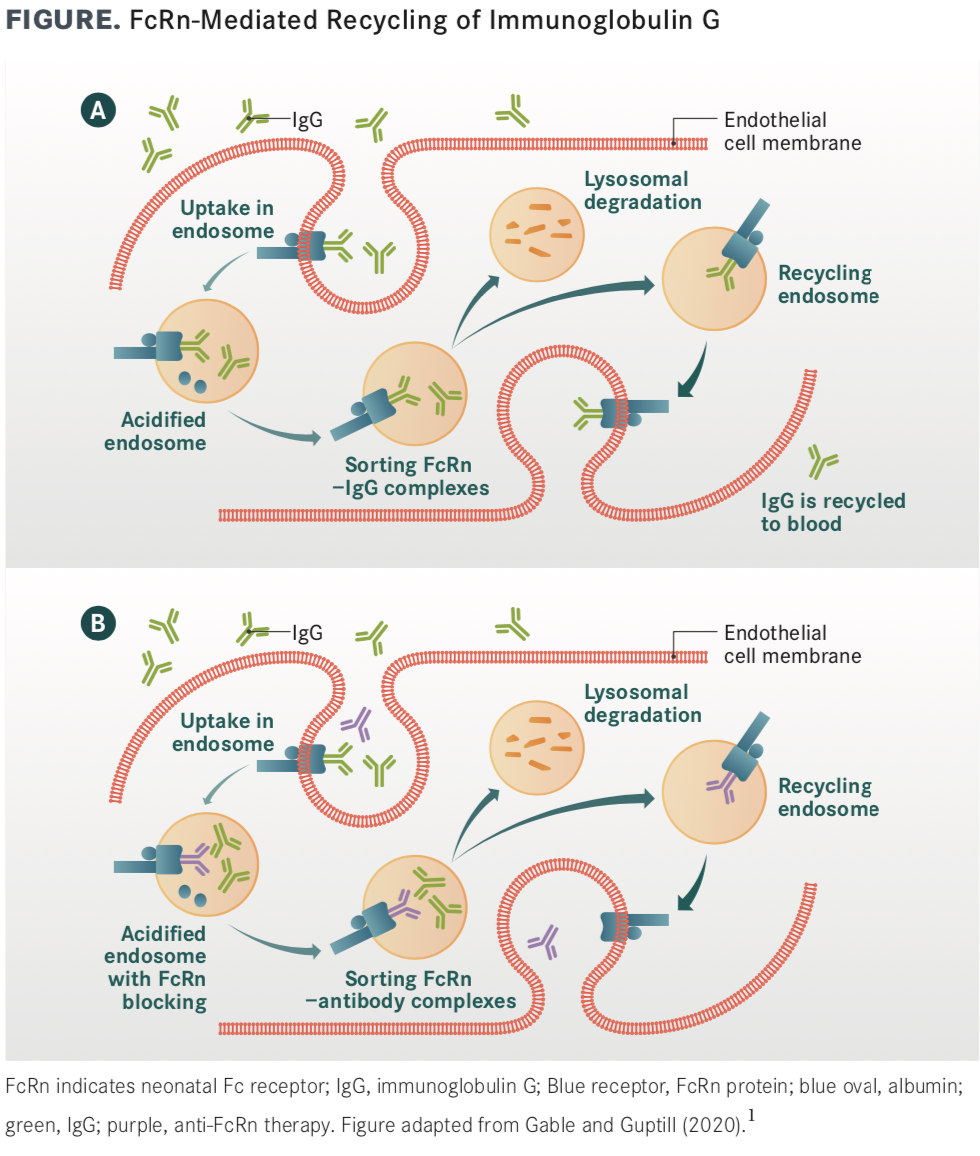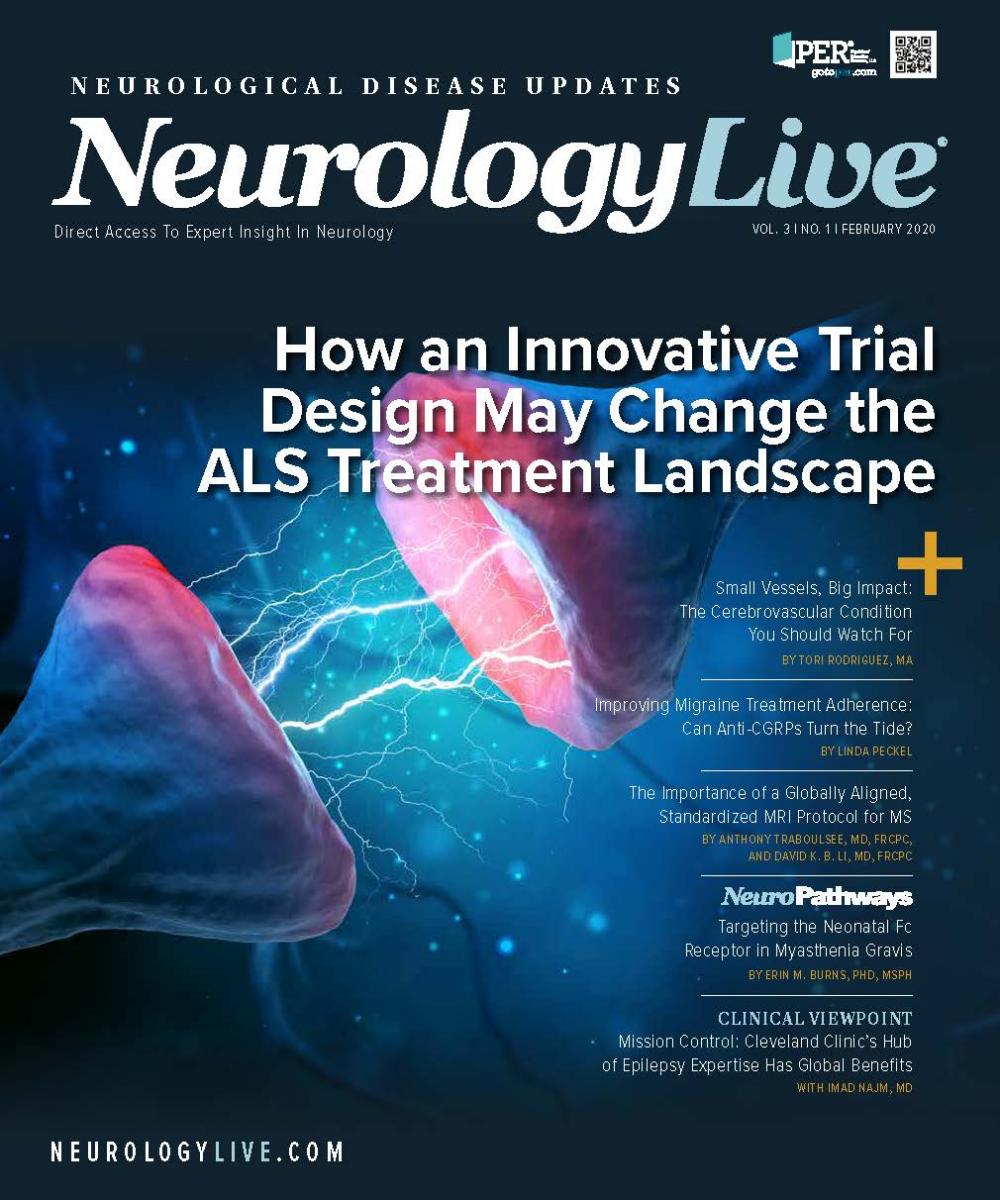Publication
Article
NeurologyLive
Targeting the Neonatal Fc Receptor in Myasthenia Gravis
Author(s):
Understanding the pathophysiology of myasthenia gravis is still being determined to this day, but the neonatal Fc receptor is emerging as a potential treatment.

Inhibition of the neonatal Fc receptor (FcRn) is currently being explored as a novel treatment approach for myasthenia gravis (MG), a disease in which immunoglobulin G (IgG) autoantibodies form against acetylcholine receptors (AChRs), muscle-specific kinase (MuSK), and lipoprotein-related protein 4 (LRP4).1,2
The pathophysiology of MG is associated with the type of auto-antibody present. AChR MG accounts for approximately 85% of cases and is characterized by the predominant expression of IgG1 and IgG3.3 These antibodies directly bind and selectively degrade the AChRs.4 Additionally, IgG1 and IgG3 activate the complement pathway, which has been implicated as the major source of destruction of the neuromuscular end plate and has been observed in both animal and human studies.5-7 MuSK MG accounts for up to 10%
of cases and is characterized by binding of MuSK autoantibodies to an Ig-like region of MuSK, which blocks activation of the agrin-LRP4-MuSK complex and inhibits neuromuscular transmission.8,9 The MuSK autoantibody primarily consists of the IgG4 subtype, which is not normally associated with complement activation.10 The transmembrane protein LRP4 functions as a receptor for agrin; after binding, these 2 proteins form a complex with MuSK, leading to MuSK activation. MuSK activation is thought to be essential for AChR clustering and formation of the neuromuscular junction.11,12

FcRn primarily functions as either a recycling receptor, maintaining high levels of albumin and IgG in the circulation, or a transcytosis receptor, responsible for the bidirectional transport of these ligands across polarized cellular barriers (FIGURE).1,13
Efgartigimod (ARGX-113) is an investigational monoclonal Fc fragment of IgG1 that has been modified at 5 residues, using ABDEG (antibodies that enhance the degradation of IgG) technology, to increase its affinity for FcRn.14,15 Molecules that harbor the ABDEG mutations (M252Y/S254T/T256E/H433K/N434F) have been shown to block the function of FcRn.14 Efgartigimod engages with and occupies FcRn, stopping its interaction with and salvage of IgG in the circulation. A multicenter, double-blind, phase 2 trial was launched to evaluate the safety, efficacy, and pharmacokinetics of efgartigimod in 24 patients with MG and generalized muscle weakness.16 The study was based on the hypothesis that patients with MG who received efgartigimod would experience therapeutic benefit if the drug reduced their levels of anti-AChR autoantibodies, similar to the total IgG decrease observed in healthy volunteers during a previous phase 1 trial of the drug.15 Participants received 4 intravenous administrations of placebo or efgartigimod over a 3-week period, followed by 8 weeks of observation.16
Frequently reported adverse events in those treated with efgartigimod included headache and reduced monocyte count, which were considered mild in severity, as well as a moderately severe 16 shingles episode reported by 1 patient treated with efgartigimod. Investigators reported a rapid and sustained reduction of IgG levels which paralleled the reduction of anti-AChR autoantibodies.
Clinical improvement was assessed using the Myasthenia Gravis Activities of Daily Living (MG-ADL), Quantitative Myasthenia Gravis, and Myasthenia Gravis Composite efficacy scales, as well as the 15-item Myasthenia Gravis Quality of Life scale.16 Clinical improvement was consistent with serum IgG and anti-AChR autoantibody levels, with effects noted 7 days after the initial infusion. Whereas IgG and autoantibody levels returned to approximate baseline levels by the study’s end, clinical scores indicated a sustained improvement throughout the study. Notably, for any point reduction level, a larger proportion of patients treated with efgartigimod experienced clinical improvement compared with those who received placebo. There was a clinically meaningful improvement in MG-ADL score for at least 6 consecutive weeks in 75% of patients treated with efgar- tigimod versus 25% in the placebo group.16
A phase 3, randomized, double-blind, placebo-controlled trial is currently under way to evaluate the safety, efficacy, and tolerability of the drug in patients with MG and generalized muscle weakness.17 The trial includes 167 participants and will assess the percentage of MG-ADL responders among those who are anti-AChR antibody seropositive, in addition to several secondary end points. The trial is expected to reach completion in November 2020.
REFERENCES
1. Gable KL, Guptill JT. Antagonism of the neonatal Fc receptor as an emerging treatment for myasthenia gravis. Front Immunol. 2020;10:3052. doi: 10.3389/fimmu.2019.03052.
2. Gilhus NE, Verschuuren JJ. Myasthenia gravis: subgroup classification and therapeutic strategies. Lancet Neurol. 2015;14(10):1023-1036. doi: 10.1016/S1474-4422(15)00145-3.
3. Verschuuren JJGM, Huijbers MG, Plomp JJ, et al. Pathophysiology of myasthenia gravis with antibodies to the acetylcholine receptor, muscle-specific kinase and low-density lipoprotein receptor-related protein 4. Autoimmun Rev. 2013;12(9):918-92 doi: 10.1016/j.autrev.2013.03.001.
4. Drachman DB, Angus CW, Adams RN, Kao I. Effect of myasthenic patients' immunoglobulin on acetylcholine receptor turnover: selectivity of degradation process. Proc Natl Acad Sci U S A. 1978;75(7):3422-3426. doi: 10.1073/pnas.75.7.3422.
5. Chamberlain-Banoub J, Neal JW, Mizuno M, Harris CL, Morgan BP. Complement membrane attack is required for endplate damage and clinical disease in passive experimental myasthenia gravis in Lewis rats. Clin Exp Immunol. 2006;146(2):278-286. doi: 10.1111/j.1365-2249.2006.03198.x.
6. Engel AG, Arahata K. The membrane attack complex of complement at the endplate in myasthenia gravis. Ann N Y Acad Sci. 1987;505:326-332. doi: 10.1111/j.1749-6632.1987.tb51301.x.
7. Morgan BP, Chamberlain-Banoub J, Neal JW, Song W, Mizuno M, Harris CL. The membrane attack pathway of complement drives pathology in passively induced experimental autoimmune myasthenia gravis in mice. Clin Exp Immunol. 2006;146(2):294-302. doi: 10.1111/j.1365-2249.2006.03205.x.
8. Gilhus NE, Tzartos S, Evoli A, Palace J, Burns TM, Verschuuren JJGM. Myasthenia gravis. Nat Rev Dis Primers. 2019;5(1):30. doi: 10.1038/s41572-019-0079-y.
9. Phillips WD, Vincent A. Pathogenesis of myasthenia gravis: update on disease types, models, and mechanisms. F1000Res. 2016;5: pii: F1000 Faculty Rev-1513. doi: 10.12688/f1000research.8206.1.
10. Huijbers MG, Zhang W, Klooster R, et al. MuSK IgG4 autoantibodies cause myasthenia gravis by inhibiting binding between MuSK and Lrp4. Proc Natl Acad Sci USA. 2013;110(51):20783-20788. doi: 1073/pnas.1313944110.
11. Kim N, Stiegler AL, Cameron TO, et al. Lrp4 is a receptor for Agrin and forms a complex with MuSK. Cell. 2008;135(2):334-342. doi: 10.1016/j.cell.2008.10.002.
12. Burden SJ, Yumoto N, Zhang W. The role of MuSK in synapse formation and neuromuscular disease. Cold Spring Harb Perspect Biol. 2013;5(5):a009167.
13. Pyzik M, Sand KMK, Hubbard JJ, Andersen JT, Sandlie I, Blumberg RS. The neonatal Fc receptor (FcRn): a misnomer? Front Immunol. 2019;10:1540. doi: 10.3389/fimmu.2019.01540.
14. Vaccaro C, Zhou J, Ober RJ, Ward ES. Engineering the Fc region of immunoglobulin G to modulate in vivo antibody levels. Nat Biotechnol. 2005;23(10):1283-1288. doi: 10.1038/nbt1143.
15. Ulrichts P, Guglietta A, Dreier T, et al. Neonatal Fc receptor antagonist efgartigimod safely and sustainably reduces IgGs in humans. J Clin Invest. 2018;128(10):4372-4386. doi: 10.1172/JCI97911.
16. Howard JF Jr, Bril V, Burns TM, et al; Efgartigimod MG Study Group. Randomized phase 2 study of FcRn antagonist efgartigimod in generalized myasthenia gravis. Neurology. 2019;92(23):e2661-e2673. doi: 10.1212/WNL.0000000000007600.
17.
An efficacy and safety study of ARGX-113 in patients with myasthenia gravis who have generalized muscle weakness (ADAPT). ClinicalTrials.gov. Updated January 27, 2020. clinicaltrials.gov/ct2/show/NCT03669588. Accessed February 3, 2020





